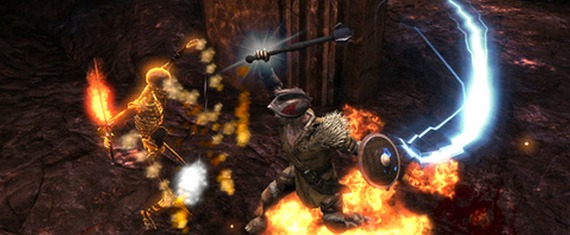 Dungeons and Dragons: Daggerdale, the new D&D game that recently reached the Xbox 360, has raised hopes for fans of the series or dungeon crawlers only to smash them right back down. The last Dungeons and Dragons game to make it to console was back in 2004, so it’s no wonder fans of the series would be thrilled to play Daggerdale. Even I was looking forward to the game, though I never played the tabletop version of D&D, because I’m a fan of dungeon crawlers and find it fun to destroy skeletons and goblins in hopes that something shiny will pop out afterward. But how does this relatively short title rank up to other dungeon crawlers and the D&D franchise? Not well at all.
Dungeons and Dragons: Daggerdale, the new D&D game that recently reached the Xbox 360, has raised hopes for fans of the series or dungeon crawlers only to smash them right back down. The last Dungeons and Dragons game to make it to console was back in 2004, so it’s no wonder fans of the series would be thrilled to play Daggerdale. Even I was looking forward to the game, though I never played the tabletop version of D&D, because I’m a fan of dungeon crawlers and find it fun to destroy skeletons and goblins in hopes that something shiny will pop out afterward. But how does this relatively short title rank up to other dungeon crawlers and the D&D franchise? Not well at all.
Overall, the story is very simple. Your main objective is to take out the big bad Rezlus. His dark spire goal is to bring in several goblins, skeleton warriors along with some other nasty guys in order to take over Dalelands. Thus the story begins.
Dungeons and Dragons: Daggerdale is a very basic dungeon crawler. I was given the choice of four archetypes, the Elven Rogue, a Halfling Wizard, the Dwarven Cleric and a Human Fighter. As you continue through your journey, you will learn and obtain special abilities along with several combos to pick off your enemies who stand against you. Combos and special abilities against your goblin and the skeleton warrior foe makes abolishing them a tad more amusing and efficient but sometimes smashing them with a blunt ax can be just as fun. The typical dungeon crawler has you taking on quests and getting rid of some baddies. However in Daggerdale, what you’re really doing is taking a quest that requires you to travel to a certain place while experiencing glitches, killing a certain number of enemies, and experiencing more glitches. I ran into framerate drops, off textures and my character was even stuck in portions of the game and left to the mercy of his antagonist. There were even times when an undead skeleton or goblin was frozen and left to my mercy (sadly, I didn’t have much mercy to show my enemy).
The dungeons to offer a vast amount of space to explore while serving quests, and the occasional side quest does come up in the game, but you’re only allowed to serve one quest at a time; multitasking is just not an option in this title. Another annoyance you will have to deal with is enemies who can revive the dead. Certain enemies look similar to each other — such as all goblins — so if you have a goblin shaman whose sole job is to revive his fallen brothers, you might run into a problem of deciphering who exactly is the shaman when in mid-battle.

Of course, this wouldn’t be a dungeon crawler if you didn’t get the opportunity to search and find rare goods like weapons and equipment. Dungeons and Dragons: Daggerdale has plenty of goodies and rarities to snatch up, but don’t get too excited about all the goodies you can discover, because you can’t equip an expansive number of items. Players will only be given a limited decision on a helmet, set of armor, a shield, a primary weapon, a ranged weapon, one amulet and only one ring. This defeats the purpose of acquiring your loot. There is no way of swapping out equipment besides what’s in your inventory, and that can get annoying fast when you really don’t know what you may face ahead in your quest. The only solution is to pick something with high enough stats and hope that gets you by. What would have been nice is the ability to equip a few more items considering different rivals will be more susceptible to certain weapons and equipments. The gold you save will most likely go toward purchasing potions until you can make a purchase of a weapon or armor with immense stats.
Where Daggerdale lacks is in the upgrade ability. You can upgrade, but it’s really basic, so there won’t be any stressing over how to spend your skill points once you achieve that next level. One more oddity is the special magic powers use. Most similar titles to Dungeons and Dragons: Daggerdale will give you a meter that shows how much juice is really left to annihilate those pesky goblins. Daggerdale only gives you a small cool down time after you use too much magic, allowing the player to quickly switch through their set of magic abilities while the cool down is complete. I found that this was fun knowing I won’t be running out of special ability juice, but it can seem little cheap. You could easily go into a horde of enemies and continually switch and use your special attacks, making them par to your normal attacks.
The game controls are rather tight, and casting spells is a breeze and surprisingly feels natural in this hack-and-slash RPG. What does cause a problem is choosing the single-player adventure path. You unfortunately lack any A.I. companion. I found myself lost at points and unsure of what way I should be going, even when using the small map with an indicator of your end point. I often ran into dead ends and was constantly backtracking. Once I found my way, I found the actual consistent waves of my enemies a dull and bland fight, making it easier just to avoid them when traveling back after a quest. Really there is no need to fight off someone you just fought five minuets earlier. Enemies can be slow at times and are easy enough to whip right through and continue on your way.
Daggerdale does offer multiplayer, which livens things up a bit. You can jump into co-op if you and buddy want to hack and slash your way through the dungeons, or you can get a group of up to four people online. However, when you join in a game there is no way of telling the other players’ level until the game starts, so you could join one team only to find that everyone else is several levels below or above you. Also, because only the game leader can see the navigation points, all other players rely on that person to travel to the destination. Glitches unfortunately surface again, and are in fact a huge problem, in the multiplayer modes, as everything experienced in the single-player campaign is there along with loading screens popping up mid-battle, causing your character to get killed and other players left stranded alone.
Adding some voiceover work would have been a nice addition as well, and after completing the main quest and checking out a few side quests, you’ll find that Daggerdale needed a few more levels too, because as a D&D game it should have been a bit longer.
If the developers had polished it all up, that is. As it stands, Dungeons and Dragons: Daggerdale has too many bugs and feels like it was developed with little care for the end result — almost as if you’re playing a beta of an unpolished title. Releasing it with plans of patching it later is unacceptable, and a much-needed delay to get all the kinks and bugs out was greatly needed. Anyone who plans to dish out $15 worth of Microsoft Points needs to realize what they are purchasing. I highly recommend that you check out similar titles on the XBLA Marketplace such as Torchlight before stepping into the cold, wet and glitch-filled dungeons of Daggerdale.
Score: 3/10 — Dungeons and Dragons: Daggerdale could have been a great title if the developers had taken the time to work out the bugs. If you’re easily frustrated over games or their glitches, you most likely will be spiking your controller on the floor and walking away in bitter shame.
Platform reviewed: Xbox 360
